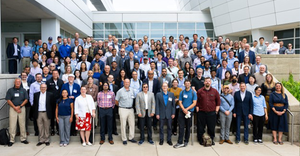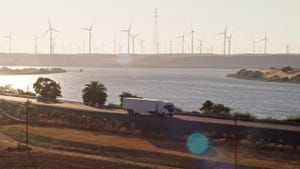Heart and Soul
December 1, 2000
Lenoa Styles
Waste Age provides a sampling of the major engines and components that will pump life into your vehicles.
Caterpillar Inc. Caterpillar Inc., Peoria, Ill., produces a range of engines, including the C-16, a 15.8 liter, delivering between 575 horsepower (hp) and 600 hp in an in-line, six-cylinder diesel engine; the C-15, a 14.6 liter diesel with 355 hp and 550 hp; the C-12, a 12-liter unit rated between 335 hp and 430 hp; the C-10, a 10.3-liter engine rated between 305 hp and 370 hp; and the 3126B, a 7.2 liter mid-range engine delivering between 175 hp and 330 hp.
Eaton Corp. Eaton Corp., Kalamazoo, Mich., manufacturers a range of transmissions for the waste industry in its Eaton Fuller 8LL family. The RTO-11908LL provides 1,150 pounds-foot (lbs-ft) of torque, the RTO-14908LL provides 1,450 lbs-ft of torque and the RTO-16908LL delivers 1,650 lbs-ft of torque, the company says. Also for the waste industry, the Eaton Fuller High-torque FR 10-speed series includes the FRO-17210C (1,750 lbs-ft of torque) and the FRO-18210C (1,850 lbs-ft of torque). The overall gear ratio for all models is 17.51-to-1, with an overdrive ratio of 0.74. The Eaton Fuller Low-Inertia Super 18 series consists of: the RTLO-14918B (1,450 lbs-ft of torque), the RTLO-16918B (1,650 lbs-ft of torque), the RTLO-18918B (1,850 lbs-ft of torque), the RTLO-20918B (2,050 lbs-ft of torque) and the RTLO-22918B (2,250 lbs-ft of torque). The company's AutoShift 10-Speed series includes the RTO-10710B-AS2 (1,050 lbs-ft of torque), the RTO-12710B-AS2 (1,250 lbs-ft of torque), the RTO-14710B/C-AS2 (1,450 lbs-ft of torque), the RTO-16710B/C-AS2 (1,650 lbs-ft of torque) and the RTO-18910B-AS2 (1,850 lbs-ft of torque).
International Truck International Truck and Engine Corp., Chicago, has five types of diesel, four-cylinder engines. Designed for specialty medium duty applications, the 530E has 275 hp to 300 hp (800 lbs-ft to 950 lbs-ft of torque) and Diamond Logic electronic controls to monitor several operational parameters, the company says. The 530E HT provides 280 hp to 330 hp (950 lbs-ft to 1,150 lbs-ft of torque) in a lighter weight design for heavy duty truck applications with weight restrictions. The T 444E has 175 hp to 230 hp (460 lbs-ft to 620 lbs-ft torque), and its DT engines - DT 466E with 175 hp to 230 hp (460 lbs-ft to 620 lbs-ft of torque), and the DT 466E HT with 195 hp to 250 hp (560 lbs-ft to 800 lbs-ft of torque) - are available for many applications.
Link Manufacturing Link Manufacturing Ltd., Sioux Center, Iowa, recently debuted the Parallelogram lift axle, weighing only 920 pounds. The axle has interchangeable frame brackets and fully adjustable hanger brackets that are designed to fit various frame widths. The expected release date is early 2001, the company says.
Raydan Manufacturing Raydan Manufacturing Inc., Nisku, Alberta, Canada, manufactures the Air Link lightweight air suspension for severe service or off-road applications. The Air Link is designed to eliminate suspension maintenance, the company says. It comes with a five-year/500,000-mile warranty on a factory-installed suspension, or a three-year/300,000-mile warranty on a retrofit suspension.
Silent Drive Silent Drive Inc., Orange City, Iowa, manufactures the AAS 721 suspension with a self-steering fabricated axle. It has steer and non-steer pusher and tag axles, with capacities ranging from 8,000 pounds to 22,500 pounds. Silent Drive also has developed a lighter weight self-steering fabricated axle.
Capacity: - Waste receiving capacity
- Users and vehicles
- Wastes handling
- Waste storage capacity
- Transfer capacity
Site: - Physical constraints
- Traffic patterns:
- Queuing, stacking and controls - Roadway geometry - Entrances and exits - Obstructions
Transfer Building Design: - Operations
- Building features
- Clear span - Clear heights - Door heights and widths - Bollards and column protection - Containment walls - Floor surfaces - Lighting
- Building Safety: - Safety concerns
- Floor spotters and signs
- Entrance lighting
- Pits and hoppers
- Fire protection systems
- Space allocation
- Environmental protection: - Dust - Wastewater - Wind and odors - Vehicle exhaust
- Building construction and safety codes
Equipment: - Compactors
- Transfer trailer selection
- Scales arrangements
Support Facilities and Services
- What is the basic Goal of the RRM? Are these goals achievable (definitely or maybe)?
- What is the best approach (considering all economic, technical, social, political and environmental factors)?
- Is the RRM necessary for facility viability or is it a cost-reduction or increased revenue consideration (e.g. to increase payload, improve operating efficiency, accommodate more waste or users)?
- How long will the existing facility or equipment last without the RRM?
- Can the RRM be avoided or delayed, and what are the consequences?
- What is the best time of year for the RRM (i.e. winter when waste deliveries are less and weather is not favorable to construction; or, spring, summer or fall that favor construction but are peak waste delivery times)?
- Has the proposed RRM considered all of the political, social, economic and environmental consequences - not just the technical ones?
- Are there any immediate health, safety or environmental risks if the RRM is not undertaken?
- How will the neighbors react?
- Can the modifications be made without posing a risk to the facility personnel or users, especially if it remains operational during the RRM?
- What are the physical limitations that must be addressed in the RRM? i.e., is there adequate space available for expansion?
- What site or facility peculiarities must be considered (e.g., easements, setbacks, right-of-ways, landscaping, utilities, visual buffers, etc.)?
- Which regulations or codes apply ?
- Are there permit concerns if the RRM does or doesn't occur?
- How do zoning regulation, solid waste permits and environmental reviews affect the decisions and timing of implementing the RRM?
- Do new building codes exist, and will an upgrade of one element require upgrades in other areas to comply with current codes?
- Is the building structurally adequate to accept/accommodate the RRM, including: Are the foundations or subsoils adequate to accept additional loading?
- Can the RRM be accomplished without facility shutdown? If not, how long with the shutdown last? Is a shutdown even a viable option?
- What is the likelihood of an unforeseen shutdown if the RRM is not undertaken?
- What affect would a shutdown have on expected cash flow or revenues?
- How would a shutdown affect users, the facility owner and operating personnel?
- If a shutdown is required, what waste handling options exist? Can intermediate transfer occur onsite, and what approvals, mitigation measures and operating conditions would be required?
- If a shutdown is required, what are the alternate transfer locations?
- What are the environmental consequences of a shutdown(s); temporary capacity reductions; user restrictions; or, interim transfer options?
- What is the life-expectancy of the facility and added life resulting from the RRM?
- What is the expected life or frequency of the RRM action? Is this a short- or long-term fix, or a re-occurring maintenance cost?
- How will the RRM be funded?
- What technologies, equipment or products should be used, e.g. proprietary products with a higher initial cost?
- How will the RRM be procured and what restrictions exist in the procurement process?
- What inspection, testing or certifications are required, especially for structural changes?
- If staff is reduced, will they be provided other, comparable jobs?
- What are the environmental considerations during the RRM (e.g., dust, odor, noise, traffic, litter, vectors, etc.)?
- Do adequate utilities exist to support changes?
- How long will it take to obtain the permit and what issues may be raised?
- Can the facility selectively restrict users during the RRM?
- What problems might be created with an RRM with existing contracts for disposal or with rate structures at the disposal site?
- If the facility is going to be shutdown for the RRM, are there other lower-priority RRMs or upgrades that might be undertaken concurrently?
- How will the appearance of the facility change following RRM completion, and how will it be perceived?
You May Also Like


